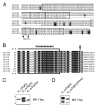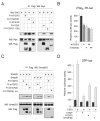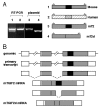The Tgif2 gene contains a retained intron within the coding sequence
- PMID: 16436215
- PMCID: PMC1402312
- DOI: 10.1186/1471-2199-7-2
The Tgif2 gene contains a retained intron within the coding sequence
Abstract
Background: TGIF and TGIF2 are homeodomain proteins, which act as TGFbeta specific Smad transcriptional corepressors. TGIF recruits general repressors including mSin3 and CtBP. The related TGIF2 protein functions in a similar manner, but does not bind CtBP. In addition to repressing TGFbeta activated gene expression, TGIF and TGIF2 repress gene expression by binding directly to DNA. TGIF and TGIF2 share two major blocks of similarity, encompassing the homeodomain, and a conserved carboxyl terminal repression domain. Here we characterize two splice variants of the Tgif2 gene from mouse and demonstrate that the Tgif2 gene contains a retained intron.
Results: By PCR from mouse cDNA, we identified two alternate splice forms of the Tgif2 gene. One splice variant encodes the full length 237 amino acid Tgif2, whereas the shorter form results in the removal of 39 codons from the centre of the coding region. The generation of this alternate splice form occurs with the mouse RNA, but not the human, and both splice forms are present in all mouse tissues analyzed. Human and mouse Tgif2 coding sequences contain a retained intron, which in mouse Tgif2 is removed by splicing from around 25-50% of RNAs, as assessed by RT-PCR. This splicing event is dependent on sequences within the mouse Tgif2 coding sequence. Both splice forms of mouse Tgif2 encode proteins which are active transcriptional repressors, and can repress both TGFbeta dependent and independent transcription. In addition, we show that human and mouse Tgif2 interact with the transcriptional corepressor mSin3.
Conclusion: These data demonstrate that the Tgif2 gene contains a retained intron, within the second coding exon. This retained intron is not removed from the human mRNA at a detectable level, but is spliced out in a significant proportion of mouse RNAs. This alternate splicing is dependent entirely on sequences within the mouse Tgif2 coding sequence, suggesting the presence of an exonic splicing enhancer. Both splice forms of mouse Tgif2 produce proteins which are functional transcriptional repressors.
Figures






Similar articles
-
The Smad transcriptional corepressor TGIF recruits mSin3.Cell Growth Differ. 2001 Sep;12(9):457-63. Cell Growth Differ. 2001. PMID: 11571228
-
The human Nramp2 gene: characterization of the gene structure, alternative splicing, promoter region and polymorphisms.Blood Cells Mol Dis. 1998 Jun;24(2):199-215. doi: 10.1006/bcmd.1998.0186. Blood Cells Mol Dis. 1998. PMID: 9642100
-
Characterization of three splice variants and genomic organization of the mouse BMAL1 gene.Biochem Biophys Res Commun. 1999 Jul 14;260(3):760-7. doi: 10.1006/bbrc.1999.0970. Biochem Biophys Res Commun. 1999. PMID: 10403839
-
Role of TG-interacting factor (Tgif) in lipid metabolism.Biochim Biophys Acta. 2015 Jan;1851(1):9-12. doi: 10.1016/j.bbalip.2014.07.019. Epub 2014 Aug 1. Biochim Biophys Acta. 2015. PMID: 25088698 Review.
-
Mammalian introns: when the junk generates molecular diversity.Int J Mol Sci. 2015 Feb 20;16(3):4429-52. doi: 10.3390/ijms16034429. Int J Mol Sci. 2015. PMID: 25710723 Free PMC article. Review.
Cited by
-
Kdm6b and Pmepa1 as Targets of Bioelectrically and Behaviorally Induced Activin A Signaling.Mol Neurobiol. 2016 Aug;53(6):4210-4225. doi: 10.1007/s12035-015-9363-3. Epub 2015 Jul 28. Mol Neurobiol. 2016. PMID: 26215835
-
Induction of Apoptosis and Growth Suppression by Homeobox Gene TGIFLX in Prostate Cancer Cell Line Lncap.Iran J Public Health. 2013 Nov;42(11):1242-52. Iran J Public Health. 2013. PMID: 26171336 Free PMC article.
-
Cytokine activation of p38 mitogen-activated protein kinase and apoptosis is opposed by alpha-4 targeting of protein phosphatase 2A for site-specific dephosphorylation of MEK3.Mol Cell Biol. 2007 Jun;27(12):4217-27. doi: 10.1128/MCB.00067-07. Epub 2007 Apr 16. Mol Cell Biol. 2007. PMID: 17438131 Free PMC article.
-
Tissue- and case-specific retention of intron 40 in mature dystrophin mRNA.J Hum Genet. 2015 Jun;60(6):327-33. doi: 10.1038/jhg.2015.24. Epub 2015 Apr 2. J Hum Genet. 2015. PMID: 25833469
-
Tgif1 and Tgif2 Regulate Axial Patterning in Mouse.PLoS One. 2016 May 17;11(5):e0155837. doi: 10.1371/journal.pone.0155837. eCollection 2016. PLoS One. 2016. PMID: 27187787 Free PMC article.
References
-
- Melhuish TA, Wotton D. The interaction of C-terminal binding protein with the Smad corepressor TG-interacting factor is disrupted by a holoprosencephaly mutation in TGIF. J Biol Chem. 2000 - PubMed
-
- Wotton D, Knoepfler PS, Laherty CD, Eisenman RN, Massague J. The Smad Transcriptional Corepressor TGIF Recruits mSin3. Cell Growth Differ. 2001;12:457–463. - PubMed
Publication types
MeSH terms
Substances
LinkOut - more resources
Full Text Sources
Other Literature Sources
Molecular Biology Databases

